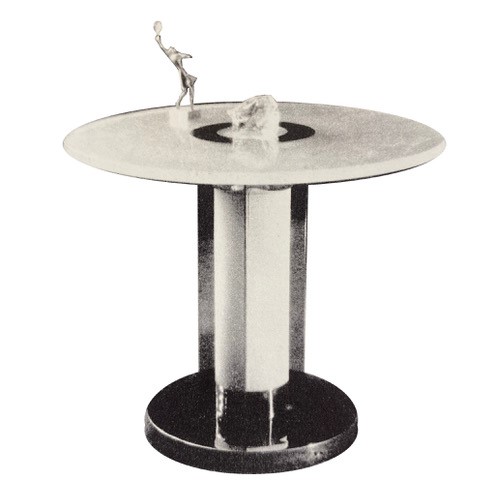Jean Perzel

(1892-1986)
For the last three years, Perzel has been painting his glass; usually in a pink, which bathes the room in a pleasant atmosphere… and gives women a flattering look,” wrote Gaston Dersy in the magazine “Mobilier et Décoration” in December 1933.
Jean Perzel was born in Bruck an der Leitha, trained as a glass painter in Munich, came temporarily to Paris in 1910 and settled entirely in Paris after the war. Like his father and grandfather, he began making glass and soon turned his attention specifically to lighting.
In an article in the magazine “Lux” he explained that renewal would only be possible if one stopped seeing a lamp as a “transformed candle.” He designed his first lamp in the style of an unpainted Romanesque church window. Perzel described the idea as follows: >>It would be presumptuous to claim that I would treat electricity as the ancient stained glass painters treated the sun, but now I have made such an attempt by completely encasing the light source in order to utilize all the rays ; My experiments with etched, milky and ivory-like glasses are also based on this<<.
Perzel’s style of lighting and its influence on his contemporaries developed from this concept. As a designer and manufacturer of lamps – the company still exists in Paris today – he was based on the opinion that, firstly, the light had to be distributed evenly over the illuminated surfaces and, secondly, the light rays had to be used to the maximum. On the question of uniformity of lighting, two camps emerged among the lamp designers, one that joined Perzel and another, whose main representative was Sabino, who took the opposing view that the light should vary irregularly and vividly through the appropriate properties of the glass be modulated.
In order to obtain the most even light distribution possible for his lamps, Perzel developed a special, sandblasted glass, one side of which was covered with a thin, transparent layer of enamel. This not only filtered the light evenly, but also created a “clouding” effect. Later he used very slightly tinted enamel coverings, for example a light beige or pink, depending on how it suited the rooms. More rarely, he also had a translucent and slightly rainbow-colored type of glass. Perzel’s metal frames, either nickel-plated or painted, discreetly supported the overall effect. Perzel produced high-quality, expensive models in relatively large quantities. Without aiming for the diversity of Genet & Michon or Sabino, he almost exclusively produced table lamps, floor lamps, appliques and ceiling lamps, and occasionally also light blocks, light columns and illuminated tables, which he is even said to have invented. The shades of his lamps, polygonal, conical, spherical, cylindrical and rectangular in shape, are of clear elegance and astonishing “modernity” in our sense. Jallot, Rollin, the Tétard brothers and the architect Roux-Spitz mainly used Perzel chandeliers for their furnishings. In addition, Perzel himself had a first-class, international clientele, including Henry Ford in Detroit, the Hotel Savoy in London and the King of Siam in Bangkok. From 1924 to 1939, Perzel exhibited at the Autumn Salon; he was also represented with his creations at the International Exhibition of 1925 and at the Salon du Luminaire in the 1930s.
Source: Alastair Duncan, Lampen Luster Candlesticks, Art Nouveau Art Déco, Prestel-Verlag, Munich 1979, pp. 180-181
Image: Alastair Duncan, lamps chandeliers, Art Nouveau Art Deco, Prestel-Verlag, Munich 1979, image 120


-
RSA Antiquitäten Wiesbaden
-
Taunusstraße 34
65183 Wiesbaden -
+49 611 5 29 05 70
-
+49 170 7 83 01 13
-
info@antiquitaeten-wiesbaden.de
-
Mondayclosed
-
Tuesday - Friday12 a.m. - 6 p.m.
-
Saturday10 a.m. - 4 p.m.